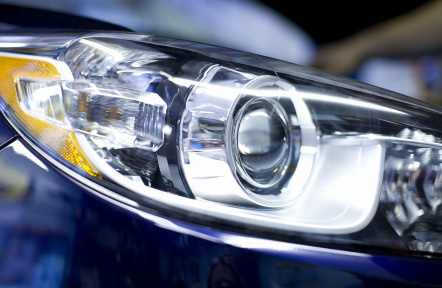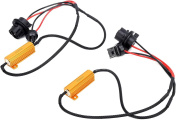
You bought a new car and are excited to take it for a spin. But as you leave your driveway, you realize something's not quite right. The headlights are pointing in the wrong direction! Don't worry, adjusting your headlights is a fairly easy process. Depending on your car, there may be a few different ways to do it. We'll go over the most common methods below.

How can you know that it`s time to adjust headlights?
The signs for a driver that you have to adjust your headlights are:
- Oncoming drivers flash their high beams at you
- You can't see the road very well at night
- Your car is frequently getting pulled over for having your high beams on
These are the most obvious signs, but what when it comes to the early signs that it may be time to adjust headlights?
- Your car starts to veer to the right or left when driving on a flat, level road
- You notice that one headlight is brighter than the other
- The light from your headlights seems scattered and not focused
If you notice any of these signs, then it's definitely time to take a look at your headlights and make some adjustments. There are three main ways to adjust headlights: manual, electronic, and automatic. We'll go over each method below.
Do all headlights have to be adjusted?
Yes, all headlights should be pointing in the same direction. This is so that you can see the road clearly and other drivers can see your car's headlights from a distance. Depending on your car, you may have to adjust one headlight or both headlights.
If you don't adjust your headlights, then you won't be able to see the road as well at night. This can be dangerous and lead to accidents. Additionally, other drivers may have trouble seeing your car's headlights, which could also lead to accidents. In some states, it is even illegal to drive with improperly adjusted headlights. So it's definitely in your best interest to make sure that your headlights are adjusted properly!
Manual Adjustment
The first way to adjust headlights is manual. This means that you'll need to physically turn the screws or levers that control the aim of the headlights. To do this, you'll need to open up the hood of your car and locate the adjustment screws or levers. The location of these will vary depending on your car model, so consult your car's manual or do a quick Google search for more specific instructions.
Once you've found the adjustment screws or levers, it's time to start making some adjustments. If your headlights are pointing too high, turn the screw or lever counterclockwise. If they're pointing too low, turn it clockwise. Make small adjustments until the beam is aimed in the right direction.

It's important to note that you should only adjust one headlight at a time. This way, you can make sure that both headlights are pointing in the same direction. Other hints on manual headlights adjustment:
- If your car has vertical adjustment screws, turn them the same amount.
- If your car has horizontal adjustment screws, turn them the opposite way each other. For example, if you turn the left screw clockwise, turn the right screw counterclockwise.
- When making adjustments, always check to see that both beams are pointing in the same direction.
Try it in a non-threatening scenario, such as an empty parking lot or a peaceful street. Make careful traveling and pay attention to your headlights' placement. If one or both lights are misaligned, you'll need to perform this procedure again.
Automatic Adjustment
If your car is newer, it may have an automatic headlight adjustment feature. This means that the headlights will adjust themselves based on the weight of the car and how much it's loaded. To use this feature, simply turn on the headlights and then turn on the engine. The lights should adjust themselves to the proper position. When you want to aim the headlights manually, you can usually find a switch inside the car that will turn off the automatic feature. Consult your car's manual to find out exactly where this switch is located.
In case you're not comfortable adjusting your headlights on your own, or if you can't seem to get them aimed correctly, you can always hire a professional to do it for you. Many car detailers, mechanics, and even car washes offer this service. It's usually not very expensive, and it will save you the hassle of trying to do it yourself.
How high should headlights be aimed?
For most vehicles, the top of the low beam should be at or just below eye level when standing in front of the car. You'll notice that on the right side (passenger side) of the vehicle, the light pattern is higher to illuminate road signs; this is for your safety and the safety of other drivers. The height should be the same on both sides of the vehicle.
How do you tell if your headlights are aimed too high?
In case you hesitate about the right position of your headlights, you can use a wall or garage door as a guide. Park your car about 25 feet away from the wall or garage door, then turn on the low beams. The light should hit the wall or door at a point that's level with your headlight (or slightly below). If the light is aimed too high, it will be above this level; if it's aimed too low, it will be below this level.
For more details watch the video below.
How to adjust headlights without 25 feet?
When you don't have a desire or an opportunity to see things far away, it's time to adjust your headlights. You can do this yourself in just a few minutes, and it's a great way to improve your visibility while driving. There are two ways to adjust your headlights: vertically and horizontally. Horizontal adjustment is simple: just loosen the screws that hold the headlight in place and move it left or right until the beam is pointing where you want it.
Vertical adjustment is a little more complicated, but still not too difficult. You'll need to raise or lower the entire headlight assembly in order to point the beam up or down. To do this, first, loosen the bolts that hold the headlight assembly in place. Once the bolts are loosened, you can raise or lower the headlight assembly by turning the adjustment screws.
Turning the vertical adjustment screws clockwise will lower the headlight beam while turning them counterclockwise will raise it. And that's all there is to it! Just remember to retighten the bolts when you're finished so that your headlights stay in place.
Can headlights be misaligned?
After you've had a car accident, check your headlights' alignment. Even if there's no accident, though, over time wiring issues can cause decreased headlight performance. Additionally, fuses that have gone bad or damage to the lenses or internal components of headlights can also lead to misalignment. Drivers will notice that their headlights are no longer shining as bright as they once did. This can cause decreased visibility while driving at night and make it more difficult to see potential obstacles in the road ahead.
You already know how to adjust headlights in your vehicles. But what if you already have them misaligned and want to fix them? There are a few different ways to adjust headlights. The most common way is to use an adjustable beam headlight alignment tool. This tool helps you to align the beam of light from your headlights so that it shines directly ahead, and not into the eyes of oncoming traffic.
Another way to adjust headlights is by using a headlight aiming screen. Headlight aiming screens are placed in front of your vehicle, and they help you to see where the beam of light from your headlights is shining. By looking at the screen, you can see where you need to make adjustments to your headlights so that they are aligned correctly.

A third way to adjust headlights is by using a tape measure. Measure the distance between the center of each headlight and the centerline of your vehicle. This will give you an idea of how far off your headlights are from being aligned. Then, use an adjustable beam headlight alignment tool to make the necessary adjustments.
No matter which method you choose, it's important to make sure that your headlights are properly aligned. Misaligned headlights can be a safety hazard, so it's best to take care of the problem as soon as you notice it. With a little time and effort, you can have your headlights shining brightly and keeping you safe on the road ahead.
Final words
Those drivers who want to properly aim headlights in their vehicles should follow the steps above. Adjusting headlights is not difficult, but it is important to make sure that they are aligned correctly. Doing so will improve your visibility while driving and help you to avoid potential obstacles in the road ahead.








